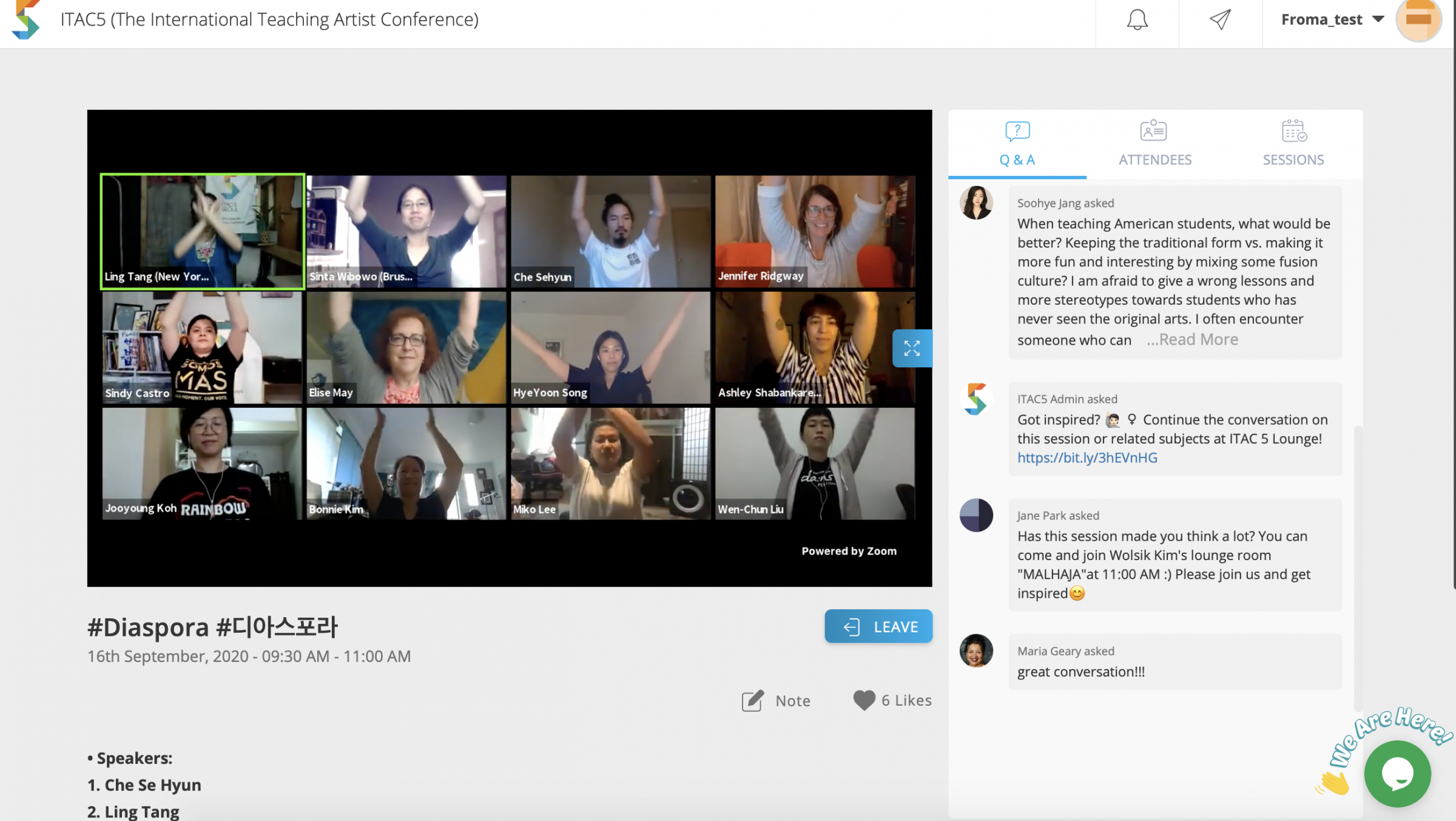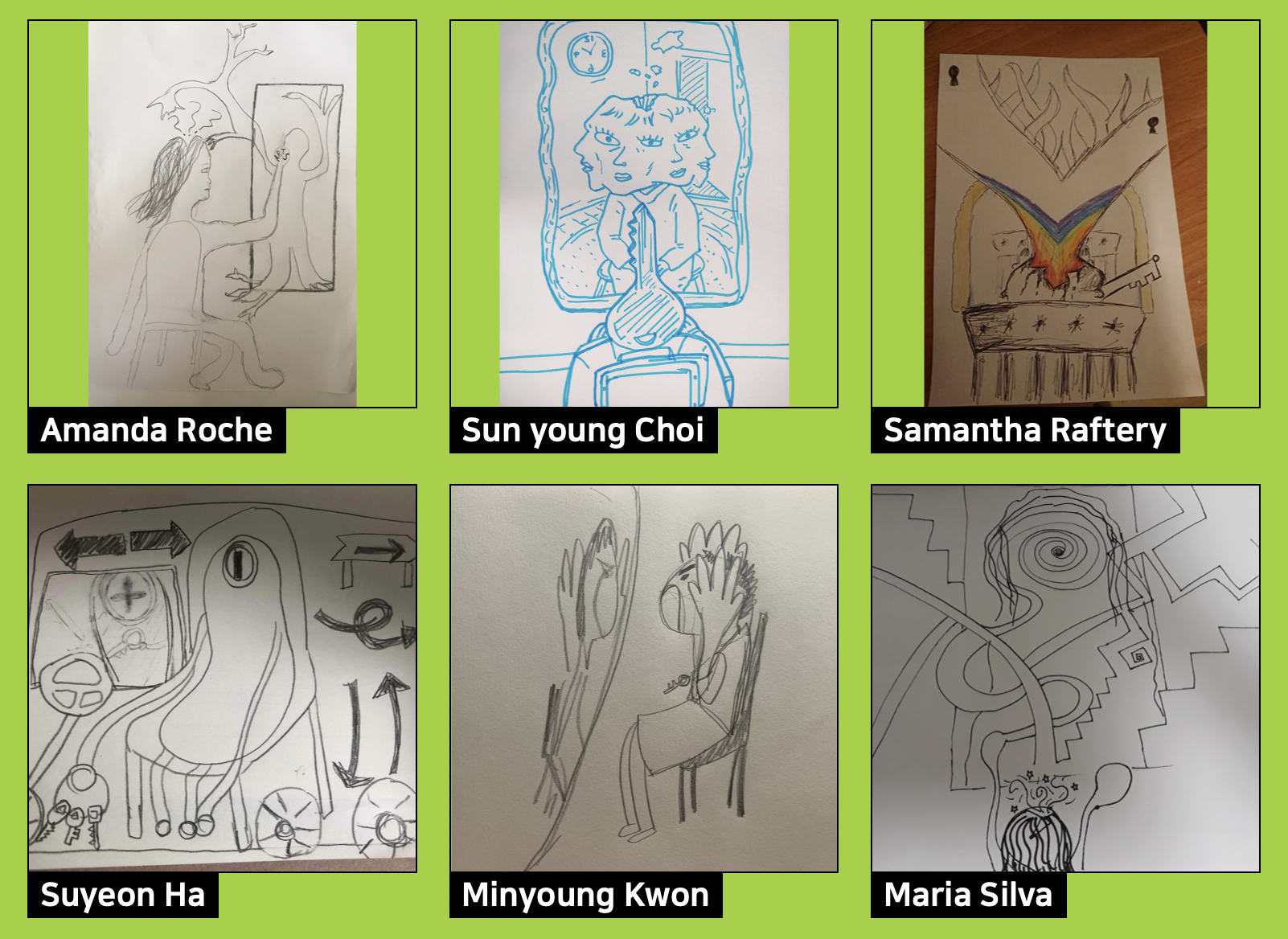KACES Newsletter Vol.14
2020
December 21
December 21
© 2020 KACES
FOCUS ARTICLES
What we learned from the success of ITAC5: Neither COVID-19 nor Social Distancing could stop the Passion for Arts Education
Opening Ceremony of ITAC5

Kim, Byoung Joo
Co-Chair, ITAC5 Programming Committee
Professor, Seoul National University of Education
Despite the challenges of COVID-19 and strengthened social distancing regulations, the 5th International Teaching Artist Conference (ITAC5) was successfully held from September 14th to 17th, 2020. Biannually held, ITAC has been a platform for teaching artists working in the fields of arts education and socially engaged arts practices to come together and exchange ideas. For the first time in Asia, South Korea hosted its 5th edition. Notably, this year’s event had to be held entirely online in the midst of the unprecedented global pandemic.
Co-Chair, ITAC5 Programming Committee
Professor, Seoul National University of Education
Despite the challenges of COVID-19 and strengthened social distancing regulations, the 5th International Teaching Artist Conference (ITAC5) was successfully held from September 14th to 17th, 2020. Biannually held, ITAC has been a platform for teaching artists working in the fields of arts education and socially engaged arts practices to come together and exchange ideas. For the first time in Asia, South Korea hosted its 5th edition. Notably, this year’s event had to be held entirely online in the midst of the unprecedented global pandemic.
I had the opportunity to participate in ITAC2 and ITAC4 as a presenter. The memories still remain vivid how inspired I was through the experiences shared by teaching artists around the world as well as the solidarity and support they offered. It was such a fascinating and unique event in that it differed from any other academic conferences which are mostly formal and uninteresting. Indeed, adopting ‘unconferencing’ as its motto, this festive gathering encouraged creative and enthusiastic interaction among various artists, educators, and community practitioners in the field. The preparation of ITAC5 took us more than 2 years, in hopes of introducing this special community to Korean teaching artists; and, nameless talented artists and devoted practitioners in Korea and Asia to the world.
No one could have foreseen, however, that the outbreak of COVID-19 would eventually force us to transform the ITAC5 into an entirely online event for the first time. We kept questioning if we would be able, via online, to recreate the pleasant energy and active interaction that ITAC used to generate; each day was an uphill battle, with unexpected challenges and endless tasks one after another.
No one could have foreseen, however, that the outbreak of COVID-19 would eventually force us to transform the ITAC5 into an entirely online event for the first time. We kept questioning if we would be able, via online, to recreate the pleasant energy and active interaction that ITAC used to generate; each day was an uphill battle, with unexpected challenges and endless tasks one after another.

Perhaps, desperate circumstances enable artists rise to the challenge with their utmost creativity. Once opened, ITAC5 saw its largest number of participants by far, with more than 1,800 from 44 countries. For three days during the conference, the web platform was filled with vibrant energy and full of excitement – more than 60 proposed sessions were eager to engage with colleagues around the world. Also, specially designed online “inter-activities” such as UCC, Online Debates, Collective Art Project, Collaborative Groups and Lounge Meetings proved that we could, via online, still connect and interact as lively as ever. Still basking in the afterglow, let us brieflylook back on what we learned from this special experience.
Taking opening ceremony conference video in studio
First of all, ITAC5 served as a timely venue for teaching artists who were thirsty for an opportunity to discuss and share their perspectives regarding the role of artsand how it gives meaning to our daily lives in a time of confusion and anxiety. Participants found solidarity and hope as they explored different ways and possibilities to revive the power and value of arts education that has become even more needed as it is faced with severe constraints brought about by social distancing regulations.
Secondly, as an online conference, ITAC5set a new standards and possibility. Although face-to-face or first-hand experiences – the essential elements of arts and arts education - were not feasible, the online conference certainly expanded the scope beyond physical and temporal limits to encompass regions that had been relatively excluded in the past: such as Asia, South America, and Africa. Domestically, its ambitiously devised strategies including a wide range of video contents, online sessions, and modes of interaction successfully complemented non-contact communication and drew more than 1,000 Korean participantswho are new to ITAC. Moreover, through inexpensive registration fees and online accessibility attracted younger generation more than ever. In addition, participants were able to review and replay uploaded videos and missed sessionsat their convenience that gave the quality of “sustainability”, which would not have been possible offline.
Lastly, ITAC5 suggested a new direction for private-public collaboration led by artists in the field, especially in Korean context. One of the key factors behind the success was that ITAC’s mission and commitment to the autonomy of those practicing in the field were respected and fulfilled. Traditionally government-driven, this became a rare precedent in which the host organizers, the Ministry of Culture, Sports and Tourism and Korea Arts & Culture Education Services (KACES), took on a supporting role behind the stage so that the Programming Committee consisted of field experts from the private sector could take the lead. A genuine and ideal partnership between the public and private domains, this is a model to be further sought in the ecology of arts and culture in Korea.
Secondly, as an online conference, ITAC5set a new standards and possibility. Although face-to-face or first-hand experiences – the essential elements of arts and arts education - were not feasible, the online conference certainly expanded the scope beyond physical and temporal limits to encompass regions that had been relatively excluded in the past: such as Asia, South America, and Africa. Domestically, its ambitiously devised strategies including a wide range of video contents, online sessions, and modes of interaction successfully complemented non-contact communication and drew more than 1,000 Korean participantswho are new to ITAC. Moreover, through inexpensive registration fees and online accessibility attracted younger generation more than ever. In addition, participants were able to review and replay uploaded videos and missed sessionsat their convenience that gave the quality of “sustainability”, which would not have been possible offline.
Lastly, ITAC5 suggested a new direction for private-public collaboration led by artists in the field, especially in Korean context. One of the key factors behind the success was that ITAC’s mission and commitment to the autonomy of those practicing in the field were respected and fulfilled. Traditionally government-driven, this became a rare precedent in which the host organizers, the Ministry of Culture, Sports and Tourism and Korea Arts & Culture Education Services (KACES), took on a supporting role behind the stage so that the Programming Committee consisted of field experts from the private sector could take the lead. A genuine and ideal partnership between the public and private domains, this is a model to be further sought in the ecology of arts and culture in Korea.
Granted, there certainly were challenges such as language barriers, cultural differences in participating and interacting, and technical difficulties which demand our further attention. Nonetheless, “inspiration,” “solidarity,” and “ethical care” were the most common feedbacks that the participants of ITAC5 left. We witnessed how artist’s passion, creativity, and willingness can make magical moments and life-changing experiences. Now it is time to start seeking ways to enable versatile and sustainable support and collaborations.
*This article is a translation of an article contributed to Maekyung in September 2020.
*This article is a translation of an article contributed to Maekyung in September 2020.
*For more information of ITAC5, please visit itac5.org
Work from collaborative arts project

Comments from ITAC5 Participants
1. What are the takeaways and experience you think are valuable to you from ITAC5?
- Collegiality across international borders; an uplifting message of confidence in the future of arts Integration.
- Hearing from practitioners in different at forms and social situations, with different values and goals - talking about and comparing our approaches to our work, successes and challenges.
- Engaging with artists across cultures is a vital exchange that inspires, invigorates and ignites the radical change needed to work towards a vibrant, equitable and creative world.
2. What were your concerns about participating in a digital conference? How was your experience of preparing and managing your actual session?
- I had no ideas at first, needed help with grasping the ideas and skills to manage the session. Prep session was very helpful to reshape the session.
- It wasn't easy for flexible communication online, but we were able to learn how to improve each other in the process of communicating with others.
Talks from closing Ceremony
3. What did you learn and earn through presenting and discussing in the sessions?
- I found my voice and that I have a lot to unlearn and advocate in the arts.
- I learned to use more objective words and be attentive to new paths and experiences
- I learned that teaching artists are flexible and willing to adapt. I learned that there may be a reasonable deal in losing the power of in-person in order to expand access. Of course, for the future, the answer is BOTH.
- The opportunity was given to reaffirm the diversity of the community and to rediscover everyone's views on arts education.
- We earned confidence in our work and projects, inspiration from other teaching artists, and equal respect for all.
4. How will your experience at ITAC5 influence your approach to teaching artistry?
- Better tech-equipped, widened view of teaching artistry yet reassured the importance of arts centered practices.
- It will give me more courage in the use of virtual space for my work.
- My experience at ITAC5 is going to influence for the composition of my online language, communication and platform as a teaching artist.
- I found my voice and that I have a lot to unlearn and advocate in the arts.
- I learned to use more objective words and be attentive to new paths and experiences
- I learned that teaching artists are flexible and willing to adapt. I learned that there may be a reasonable deal in losing the power of in-person in order to expand access. Of course, for the future, the answer is BOTH.
- The opportunity was given to reaffirm the diversity of the community and to rediscover everyone's views on arts education.
- We earned confidence in our work and projects, inspiration from other teaching artists, and equal respect for all.
4. How will your experience at ITAC5 influence your approach to teaching artistry?
- Better tech-equipped, widened view of teaching artistry yet reassured the importance of arts centered practices.
- It will give me more courage in the use of virtual space for my work.
- My experience at ITAC5 is going to influence for the composition of my online language, communication and platform as a teaching artist.
© 2020 KACES